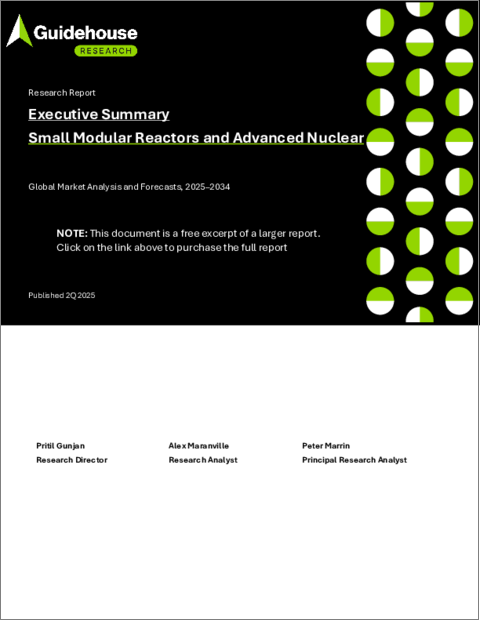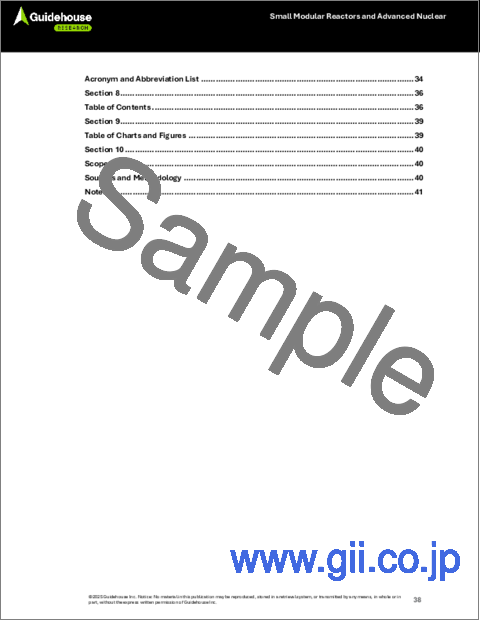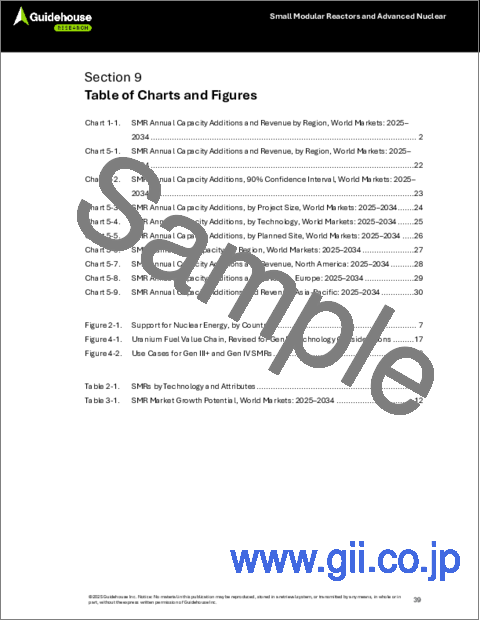|
|
市場調査レポート
商品コード
1753872
小型モジュール炉と先進原子力市場Small Modular Reactors and Advanced Nuclear: Global Market Analysis and Forecasts, 2025-2034 |
||||||
|
|||||||
| 小型モジュール炉と先進原子力市場 |
|
出版日: 2025年06月18日
発行: Guidehouse Research
ページ情報: 英文 43 Pages
納期: 即納可能
|
全表示
- 概要
- 目次
小型モジュール炉(SMR)は、エネルギー需要の加速化、特に柔軟性を備えた安定した電力、そしてエネルギーシステムの脱炭素化への継続的な移行が触媒となって、今後10年間でその役割を増大させる可能性があります。風力と太陽光がエネルギー・ポートフォリオに占める割合が高まる一方で、これらの断続的なエネルギー源には基本的な制約があります。電池は短期的なエネルギー貯蔵を提供できますが、高価で、時間とともに劣化します。逆にSMRは、年間を通じて最小限のメンテナンスで、24時間365日クリーンな固定電力を供給することができます。SMRは拡張性があり、需要に合わせてモジュールを積み重ねることができます。先進炉(AR)技術には、産業レベルの熱生産、迅速な立ち上げ・立ち下げの柔軟性、さらには大型バッテリーのようなエネルギー貯蔵といった使用事例が追加される可能性があります。
当レポートでは、2025年から2034年までのSMRの容量増加と収益予測を示し、この技術の主な促進要因と抑制要因について解説します。予測は、世界の地域別(北米、欧州、アジア太平洋、ラテンアメリカ、中東・アフリカ)、技術タイプ別、規模別、立地別、原子炉の世代別に区分されています。容量はメガワット、売上は2025年の米ドル単位でお届けします。収益とは、原子炉の立地、機器・部品の調達、建設に関連する初期費用、運転、保守、燃料費用を指します。原子炉の大きさには大きなばらつきがあり、在庫のSMRの数も限られているため、予測はどの年においても大きなばらつきがあります。原子炉容量の数値は、10,000回の繰り返しの各年の平均値であるため、パイプラインにある特定の原子炉容量に合計されない可能性があります。
目次
第1章 エグゼクティブサマリー
- 市場イントロダクション
- 世界的展望
第2章 市場の問題
- イントロダクションと範囲
- 市場促進要因
- 産業およびデジタルインフラのニーズ
- モジュール性
- 新たな好意的な世論
- 柔軟性と負荷追従能力
- 市場抑制要因
- 高コストと不確実性
- 規制とライセンシングのハードル
- サプライチェーンの問題
- 限定的な実証サイト
第3章 政策の見直し
- イントロダクション
- 北米
- 米国
- カナダ
- 欧州
- 英国
- フランス
- アジア太平洋
- ロシア
- 中国
- 日本
- 韓国
- ラテンアメリカおよび中東・アフリカ
第4章 産業バリューチェーン
- 核燃料バリューチェーン
- 鉱業、濃縮、燃料製造業者
- 北米
- 欧州
- アジア太平洋
- ラテンアメリカ
- 中東・アフリカ
- 機器および原子力部品プロバイダー
- 開発者
第5章 市場予測
- 調査手法
- 世界市場概要
- 北米
- 欧州
- アジア太平洋
- ラテンアメリカおよび中東・アフリカ
第6章 結論・提言
- 主なポイント
- 推奨事項
- 開発者
- 政策立案者
- 規制当局
- 投資家
第7章 頭字語と略語一覧
第8章 目次
第9章 図表
第10章 調査範囲、情報源、調査手法および注記
Small modular reactors (SMRs) may play an increasing role in the next decade, catalyzed by accelerated energy demand, particularly firm power with flexibility, and the continuing transition to decarbonize the energy system. While wind and solar are a growing proportion of the energy portfolio, there are fundamental constraints to these intermittent energy sources. Batteries can provide short term energy storage but are expensive and degrade over time. Conversely, SMRs enable 24/7 clean firm power, with minimal maintenance throughout the year. SMRs are scalable, comprised of modules that can be stacked together to match demand. Advanced reactor (AR) technology may have added use cases, such as producing industrial-level heat, flexibility to ramp up and down quickly, and even store energy like a large battery.
This report provides forecasts for SMR capacity additions and revenue from 2025 to 2034, and explains the technology's primary drivers and barriers. Forecasts are segmented by global regions (North America, Europe, Asia-Pacific, Latin America, Middle East & Africa), as well as technology type, size, location, and reactor iteration. Capacity is in megawatts of electricity, and revenue is in 2025 U.S. dollars. Revenue refers to the upfront costs associated with the reactor's siting, equipment and components procurement, and construction, as well as operation, maintenance, and fuel costs. The forecast has a high variance in any given year because of the large variance in reactor size and the limited number of SMRs in the inventory. The capacity number is the average of what happens in each year across 10,000 iterations, so numbers may not total to specific reactor capacities in the pipeline.
Table of Contents
1. Executive Summary
- 1.1 Market Introduction
- 1.2 Global Outlook
2. Market Issues
- 2.1 Introduction and Scope
- 2.2 Market Drivers
- 2.2.1 Industrial and Digital Infrastructure Needs
- 2.2.2 Modularity
- 2.2.3 Renewed Favorable Public Opinion
- 2.2.4 Flexibility and Load-Following Capabilities
- 2.3 Market Barriers
- 2.3.1 High Costs and Uncertainty
- 2.3.1.1 Paper Reactors Feed Uncertainty
- 2.3.1.2 Rising Fuel Costs
- 2.3.2 Regulatory and Licensing Hurdles
- 2.3.3 Supply Chain Issues
- 2.3.3.1 SMR Labor Constraints
- 2.3.3.2 Geopolitical Supply Constraints
- 2.3.4 Limited Demonstration Sites
- 2.3.1 High Costs and Uncertainty
3. Policy Review
- 3.1 Introduction
- 3.2 North America
- 3.2.1 U.S.
- 3.2.2 Canada
- 3.3 Europe
- 3.3.1 UK
- 3.3.2 France
- 3.4 Asia-Pacific
- 3.4.1 Russia
- 3.4.2 China
- 3.4.3 Japan
- 3.4.4 South Korea
- 3.5 Latin America and Middle East & Africa
4. Industry Value Chain
- 4.1 Nuclear Fuel Value Chain
- 4.2 Mining, Enrichment, and Fuel Fabrication Providers
- 4.2.1 North America
- 4.2.2 Europe
- 4.2.3 Asia-Pacific
- 4.2.4 Latin America
- 4.2.5 Middle East & Africa
- 4.3 Equipment and Nuclear Component Providers
- 4.4 Developers
5. Market Forecasts
- 5.1 Methodology
- 5.2 Global Market Overview
- 5.2.1 North America
- 5.2.2 Europe
- 5.2.3 Asia-Pacific
- 5.2.4 Latin America and Middle East & Africa
6. Conclusions and Recommendations
- 6.1 Main Takeaways
- 6.2 Recommendations
- 6.2.1 Developers
- 6.2.2 Policymakers
- 6.2.3 Regulators
- 6.2.4 Investors






